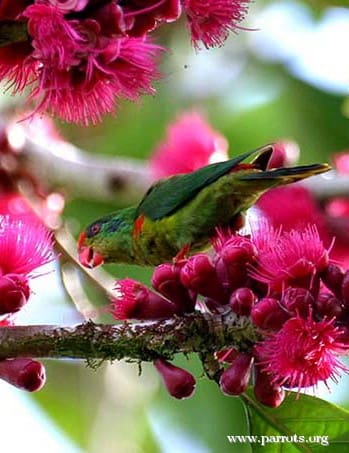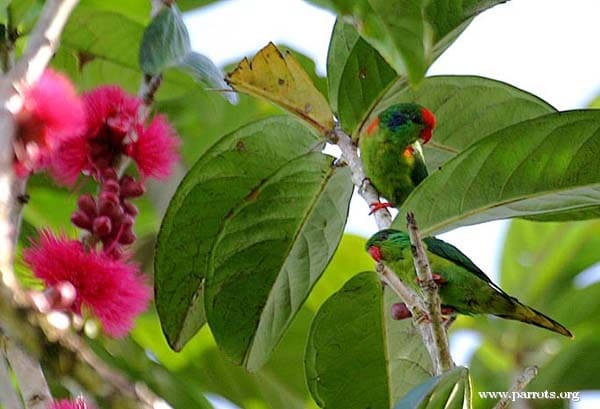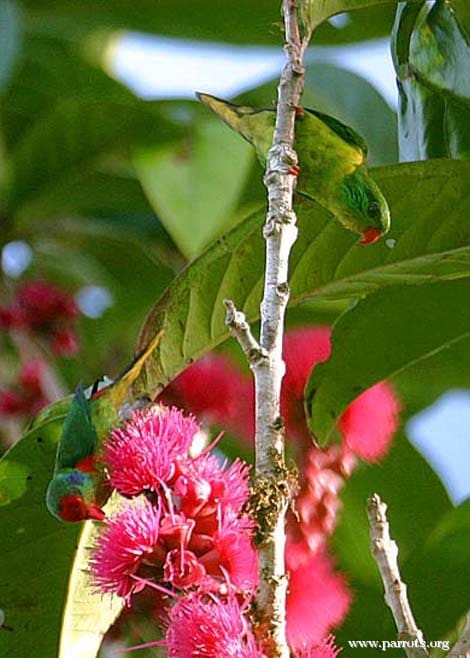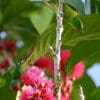Red-fronted Lorikeet
Also known as:
Red-spotted Lorikeet, Red-rumped Lorikeet
Also known as:
Red-spotted Lorikeet, Red-rumped Lorikeet

Charmosyna

rubronotata
Size:
17 cm (6.6 in)
Weight:
30-35 g (1 x 1.22 oz)
Subspecies including nominate:
two: C.r. rubronotata, C.r. kordoana
Colour Adult:
C.r. rubronotata: Male-red forecrown; purple/blue ear coverts streaked with paler blue; uppertail coverts have red marking; red underwing coverts to sides of breast, not reaching flanks; green tail tipped with yellow, with red at base of side tail feathers. Beak red. Eye orange. Female-green forecrown; green ear coverts streaked yellow/green; upper tail coverts red markings; green underwing coverts to sides of breast.
C.r. kordoana: Male-paler red on forecrown farther reaching; more blue on ear coverts, less violet. Female-as in rubronotata.
Colour Juvenile:
C.r. rubronotata: As in adult female, but males have red underwing coverts; ear coverts are dark and not streaked; underwing band yellow. Beak brown. Eye pale brown.
C.r. kordoana: As in rubronotata.
Call:
Calls made in flight are soft, but harsh. Also sharp kss notes.
More Information:
Content Sources:
CITES
BirdLife International
Cornell Lab of Ornithology/Birds of the World
Parrots: A Guide to Parrots of the World, Juniper and Parr, 1998
Parrots of the World, Forshaw, 2006. 2010 edition
Lexicon of Parrots, Thomas Arndt.
Parrots in Aviculture, Low, 1992.
Captive Status:
Uncommon
Longevity:
—
Housing:
Enclosure 6′ x 3′ x 6′ (2.3 x 1.1 x 2.3 m) with well drained, tiled or concrete floor, or indoor cage 4′ (1.5 m) long with same.
Diet:
Nectar, either commercial type for small species or homemade from lactose-free baby cereal, honey and malt extract or molasses, mixed with filtered water and made fresh once or twice daily; fruit such as: apple, pear, orange, banana, pomegranate, cactus fruits.
Enrichment:
Enjoys bathing so provide overhead misters or shallow bowls of water. Also avid chewers so provide bird-safe, unsprayed flowering, fir, willow, elder or pine branches; wooden or vegetable tanned leather toys, easily cleaned; heat sterilized pine cones.
Nest Box Size:
Vertical box 7″ x 7″ x 15″ (17.8 cm x 17.8 cm x 38.1 cm).
Clutch Size:
2
Fledging Age:
7 weeks
Hatch Weight:
—
Peak Weight:
—
Weaning Weight:
—
World Population:
Unknown; described as locally common but rare compared to other Charmosyna species. Decreasing.
IUCN Red List Status:
Least Concern
CITES Listing:
Appendix II
Threat Summary:
Common in places, but generally not as abundant as similar species. Is considered to have a medium dependency on forest habitat, and tree cover within its range is estimated to have declined by 2.1% over the past 10 years. Therefore, it is tentatively suspected that this may have led to a 1-19% decline in the species’ population over the same period.
Range:
C.r. rubronotata: Salawati, W Papuan Islands, West Papua, and NW New Guinea.
C.r. kordoana: Biak Island, West Papua.
Habitat:
Found up to 900 m (2952 ft) in humid forest, forest edges and coconut plantations, with occasional visits to trees and shrubs in open country.
Wild Diet:
Feeds on pollen, nectar and flowers in tall flowering trees, including coconut blossoms.
Ecology and Behaviour:
Seen in small flocks of up to 10 individuals flying over forest. Will feed with other species of lorikeet feeding on flowers in the canopy.
Clutch and Egg Size:
2 eggs, 17.0 x 13.5 mm (0.6 x 0.5 in).
Breeding Season:
Presumably July-August.
Related Links:
—





